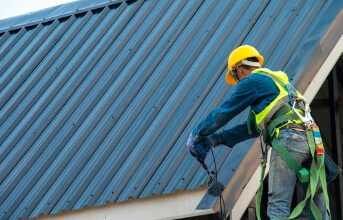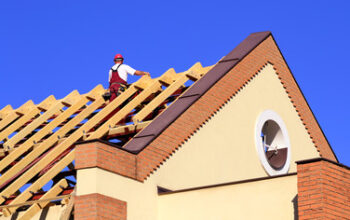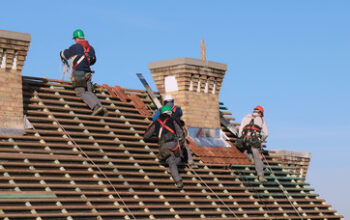Just as an oil change at a mechanic saves money in the long run, routine maintenance on a roof can prevent significant and costly problems down the road. Many manufacturer warranties also require regular inspections and maintenance.
Detecting and correcting small roof problems like a small split in wall flashing, open pitch pockets, or a loose coping metal panel before they become major problems can save thousands of dollars in future repair costs.
The roof is the barrier between your family and the elements, so it’s important to keep it in good shape. A dingy-looking roof not only detracts from your home’s curb appeal but it can also lead to expensive structural problems down the road. In addition to protecting your family from obvious dangers like weather events, falling tree branches, and excess moisture that could cause mold, a well-maintained roof can help lower your energy bills by retaining heat in the winter and cooling air in the summer.
The most obvious sign that your roof needs cleaning is black streaks or a buildup of moss or algae. If you notice these signs, you should call in a professional for a roof cleaning immediately. This type of microorganisms can damage or erode the underlayment, and if left untreated it may eventually lead to roof leaks or even shingle delamination.
A roof that is in good condition will last longer, and regular inspections can catch potential issues before they become serious. A visual inspection of the entire surface should be done at least twice a year to check for loose shingles, cracks and other potential damage. You should also look for plant growth, especially if there are overhanging trees that can drop debris and leaves on the roof or promote moss and algae growth.
One of the safest ways to clean a roof is by using the technique of soft washing, which uses a gentle cleansing agent to remove grime and dirt. This method is more effective than pressure washing and is better for the environment. It can also be used to safely remove moss, lichen and bird droppings.
If you choose to use the soft washing method, it is best to apply it on a cool day. This will allow the solution to penetrate and kill the moss, lichen and algae. It can take a few months for the stains to completely disappear, but once they do, your roof will be free from harmful growths and will look and function like new.
Keeping your roof properly maintained can prevent expensive repairs, increase its lifespan and enhance the beauty of your home’s exterior. Although determining the optimal frequency of roof cleaning can be difficult, a general rule is to have it cleaned every 3-5 years. This schedule should be adjusted depending on your climate and the presence of debris, moss, algae or other organisms.
Inspect the Attic
The attic plays a big part in your home’s overall temperature regulation, and poor insulation can lead to problems. Your inspector should look for issues like blown in insulation, gaps between rafters and sheathing, and sagging shingles. They should also check for proper airflow, which is important since hot attic air can cause condensation and rot.
Your inspector should inspect the structure of your attic, including rafter framing, sheathing, and ventilation. They should look for signs of leaks, including dampness and mold. They should check for the presence and condition of fire-rated drywall or insulation, and they will make sure that any wiring in the attic is not covered with insulation, which can be a fire hazard.
During an attic inspection, your inspector should pay particular attention to any vents that pass through the roof. They should be inspected to ensure that they are not blocked by any debris and that they are free of corrosion. They should also be checked to ensure that they are positioned properly so that hot attic air is not pushing down on cold roof areas.
Your attic should be well-ventilated to prevent damage to your roofing system and to help control moisture in the house. Proper attic ventilation allows cool air to enter the attic and hot, damp air to escape. Moisture in the attic can cause rot, mold and a host of other problems. Indicators of inadequate attic ventilation include a high attic temperature in the summer, dark spots on the ceiling and a musty odor in the house.
You should have the attic of your home inspected regularly, especially during the change of seasons. Moisture and condensation tend to be more of an issue in the winter when the attic is warmer and humid, while they are less of an issue in the summer when the attic is cooler and drier.
If you are doing an attic inspection yourself, be sure to wear a mask, safety glasses and a hard hat or cap to protect yourself from nails, screws, and beams. Also, make sure to use a good flashlight and wear long pants and a jacket. A camera and a dust mask are helpful for taking pictures of your findings.
Clean the Gutters
Clogged gutters give rainwater nowhere to go and can soak through shingles, rot the soffit and cause water damage in your home. The sitting debris also promotes mold and mildew. Lastly, the weight of clogged gutters can pull them away from the roof, leaving a gap for water to saturate the walls and ceilings.
Clogs in gutters are caused by leaves and other debris, as well as deterioration of the gutter material from age and sunlight. The best way to prevent clogs is to install gutter guards that prevent debris from entering the gutter while still allowing water to flow through them. Gutter guards are available at most hardware stores and are fairly inexpensive.
Cleaning the gutters isn’t the most fun chore but it’s an important part of roofing maintenance. Getting it wrong can be disastrous, so it’s best to leave this one to the professionals unless you have experience climbing ladders and using a power washer.
Before you start to clean the gutters, make sure that all the accumulated debris has been raked off the roof surface. Otherwise, the next rain will wash it down into the newly cleaned gutter, clogging it up all over again. You can use a hose to spray the debris down and out of the gutter, but it’s wise to wear work gloves, especially as some of the debris can be quite sharp. You should also wear eye protection, as you never know what might fly out of the downspout while you’re removing a clog. People have reported seeing rats, birds, frogs and even bees flying out of downspouts.
If you have an extension pole with a nozzle, it can be very helpful for getting to those hard-to-reach areas. You can also purchase a gutter cleaning tool that attaches to an extended ladder, making it easier and safer to get up on the roof and clean the gutters. If you’re going to be cleaning the gutters while standing on a ladder, it’s essential to check for electrical wires that are close to the roofline and do a visual inspection of the wires to ensure that they haven’t been damaged by wind, rain or other factors.
Inspect the Chimney
Your chimney and venting systems can be a significant source of smoke damage and carbon monoxide poisoning, and they should be regularly inspected to ensure that they are safe and functioning properly.
You can perform a quick visual inspection yourself, and this should be done before using your fireplace or having someone else sweep it. Look for blockages, cracks, excessive creosote build-up and deterioration of the mortar joints. You should also check that the damper is open before lighting a fire. If you have a metal chimney cap, this should be inspected as well, to make sure that it isn’t cracked or missing.
If you have a wood-burning fireplace, you should consider installing a flue liner. These are available at most hardware stores and home improvement centers, and they offer a smooth, easy-to-clean surface that enables the fireplace to draft properly. In addition to a flue liner, you should consider installing a new chimney cap, which helps prevent water leaks and keeps out animals, debris and rain.
You should schedule a Level 1 chimney inspection at least once per year. This is the most basic type of inspection, and it covers only the readily accessible portions of your chimney structure and flue. The cost is typically very reasonable, and you may be able to have it performed in conjunction with having your chimney swept.
During a Level 2 chimney inspection, your inspector will check the entire chimney structure and flue lining for safety issues. He or she will examine the parts of the chimney that can be reached without ladders and other equipment, and he or she will inspect the chimney crown, which is the downward-sloping cement shoulder at the top of the chimney that diverts rainwater away from the chimney to prevent erosion.
You should have your roof and chimney inspected after severe weather events, and you should also get them inspected when you’re changing heating systems or adding new appliances that require venting. These inspections will help you identify problems early, so you can fix them before they turn into expensive repairs and even a house fire.



